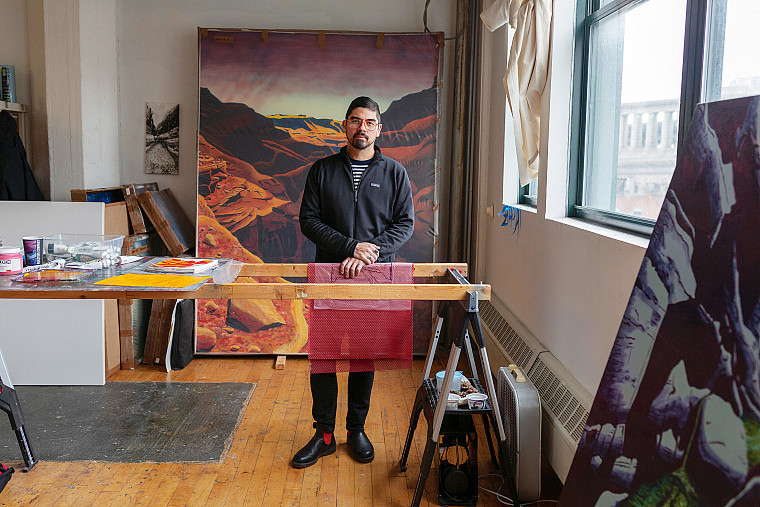main content Finding Art in Nature
Open gallery

When the pandemic hit in 2020, Kimo Nelson sequestered himself inside his home in Brooklyn, New York. Locked down from even making local trips to his studio, he drew inspiration from a recent trip to Hawaii‘i. Visions of erupting volcanoes rumbled around in his brain as he began to draw.
WHO
Kimo Nelson BA ’02
ACADEMICS
BA in environmental studies with an art minor, Lewis & Clark | MFA in painting with honors, Rhode Island School of Design
L&C MENTORS
Art faculty: Barbara Bartholomew, Bruce West, Phyllis Yes
CANVAS IN THE WILD
Nelson once hauled a large canvas up a mountain in a cargo box to draw and paint en plein air.
Unique as the experience was,he now creates exclusively at home or in his studio.
WEBSITE
“My latest Kilauea chalk pastel drawing series represents the immediacy of a rupturing volcano,” he says. “It’s a departure from my layered canyon paintings that suggest erosion over time.”
Born in Honolulu, Nelson is an American landscape artist who has exhibited nationally at galleries and nonprofit spaces. His style stems from questioning how landscapes affect the human psyche, how external spaces influence people’s internal space. In a time when climate change and opposing land use viewpoints often dominate the news, Nelson continues to infuse his artwork with the sensory experience of being outdoors in nature.
“Indirectly, my work draws attention to conversations surround- ing human interactions with protected wilderness areas,” he says. “Many of these wild spaces have become politically contested, but the beauty of art can remind people of nature’s worth.”
Nelson began his work as an explorer, collecting found objects, photographs, drawings, and audio recordings from his travels. His father’s job with the U.S. State Department necessitated his family’s moving between the United States, Southeast Asia, and the Middle East. Along the way, he was exposed to great art and architectural wonders, including places like the Sistine Chapel in Vatican City and the great pyramids of Egypt. “Images of those pyramids were burned into my 5-year-old brain.”
Eventually, Nelson’s family settled in Salt Lake City, and he started working as a professional river guide in Arizona, Utah, and Alaska. His passions for art and the environment soon melded, and he began painting and drawing wilderness landscapes. Inspired by memories and sensory data he’d collected, he tackled several thematic series.
His artistic process shifts depending on the subject. For example, his canyon series evolved directly from his time as a professional river guide. These vivid acrylic paintings have a topographical feel, created using a layering process similar to screen printing.

Aside from his creative passions, Nelson has discovered a love for long-distance running. He ran his first marathon in Hawaii‘i in 2019 and his second in New York City two years later.
“Running gives me the same sense of space and freedom that I get out in nature,” says Nelson, calling New York City and wilder- ness areas two sides of the same coin. “Looking up at towering manmade structures in lower Manhattan feels familiar—similar to being surrounded by massive natural canyons on rafting trips.”
—by Pattie Pace
More L&C Magazine Stories
L&C Magazine is located in McAfee on the Undergraduate Campus.
MSC: 19
email magazine@lclark.edu
voice 503-768-7970
fax 503-768-7969
The L&C Magazine staff welcomes letters and emails from readers about topics covered in the magazine. Correspondence must include your name and location and may be edited.
L&C Magazine
Lewis & Clark
615 S. Palatine Hill Road
Portland OR 97219

